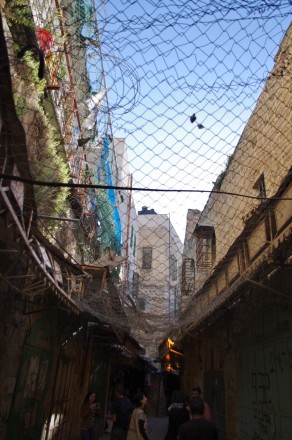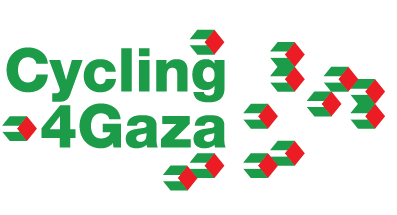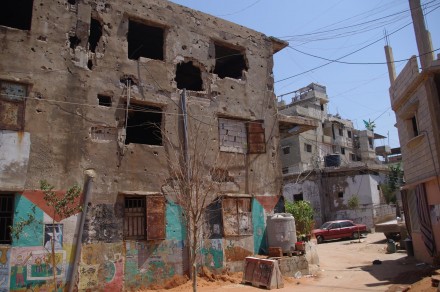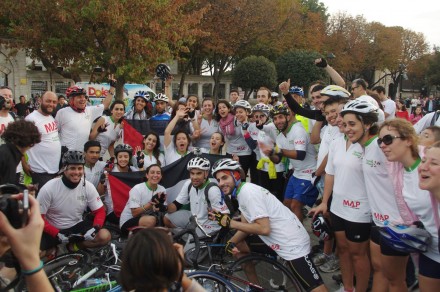This week, we hear from another one of our dear cyclists, Simon Lam (aka legs of steel). He tells us about what led him to sign up for the Turkey cycle challenge: starting with his trip to Palestine earlier this year.

‘If you head to the West Bank, you will see the massive Wall which is supposed to improve security…’
My journey did not start from Istanbul, it started with this conversation back in 2011. It was not a political talk; I was meeting the coordinator of the Palestine Children’s Relief Fund (PCRF) about opportunities to volunteer in a Palestinian refugee camp. It was the first time I heard about ‘The Wall’. I thought it was a security fence, like what you would have expected in any borders in other parts of the world. Intrigued by this conversation, I went on and started some basic research. I soon found out that part of the wall is a concrete barrier at 8 metres high with watchtowers. Apparently Palestinian families have been separated as a result of this wall, which in certain places divides Palestinian towns in two. I could not believe I was totally ignorant about this.
I tried to read books and newspaper articles written from the perspective of both the Palestinians and Israeli sides. But as you can imagine, the history of the conflict is very complex. The more I read, the more confused I became about the situation. And so, I set off for my first visit to the West Bank in March this year. Part of my visit was purely down to my love of travelling, but it was also a good way to understand more. My curiosity turned out to be a life changing experience.
I went through the border crossing on the Jordanian border at the Allenby Bridge. Holding a Hong Kong passport, I was put on a bus with other non-Arabs passport holders. I waited on the bus for more than one hour. The Israeli immigration hall was busy, but it was nothing unusual. There were six other buses, all for Arabs. Somehow the bus I was on received the approval to leave first. Then I joined a long queue, supposedly for a preliminary passport check. An official politely told me and some other western passport holders that we could skip this queue and head to the main immigration hall. In total, it took me 5 hours to clear immigration. Who knows how long those Arab passport holders had to wait. That was my first glimpse of Palestinian life in the Occupied Territories.
Then there was ‘The Wall’. In 2002, following the outbreak of the Second Intifada, Israel started constructing the West Bank Barrier. The Barrier’s total length (constructed and projected) is approximately 708km, and 60% of it is now complete. Not a single photo would allow you to grasp the sheer scale of it. I met an Arab lady from Bethlehem at the ‘Rachel’s Crossing’ checkpoint. Jerusalem was 8km away, but she needed a permit to cross the checkpoint. Curious about the paper she was holding, I asked her, ‘why do you need to go to Jerusalem?’ She replied, ‘I am going to visit my sister who lives in Jerusalem.’ She added that it took her about 3 months to get that permit. I asked her how long she was going to stay, she pointed out to the permit – it stated that she had to be back by 10pm on the same day.

Hebron checkpoint
Palestinians with West Bank ID cards who are granted special permits can only enter East Jerusalem through four of the fourteen Barriers checkpoints around the city. Even with a permit, crossing a checkpoint is not an easy task. The term ‘checkpoint’ can be rather misleading. The ‘Rachel’s Crossing’ checkpoint for example has such a large infrastructure that I felt like I was crossing into another country. Going through the checkpoint was a very strange experience. First, there was a metal chute and then a revolving door that was controlled electronically. It looked like a cattle gate that transport livestock rather than human beings. It often stopped suddenly and anyone could be stuck inside for a short time. It was such a strange experience that when I got stuck in this revolving door the first time, I found it rather funny. Perhaps not quite so for those who had to endure this on a regular basis. After this, it was the usual process of walking through the metal detector and putting personal belongings through a scanner. However, there was always something unusual: no security personnel in sight. With the help of security cameras, the army officers in charge would communicate through a loud speaker. The instructions could be quite polite, but very often I heard officers yelling at people. Anyone who failed to pass the metal detector had to go back and try again. It could be just a matter of taking shoes or belt off. If that did not work, the instruction was to take some clothes off, as body searches were not an option. It was not nice to have witnessed such incidents several times, in fact it was humiliating. After clearing the metal detector, we would finally pass through to the officers in charge so that they could check our documents. Usually they would not inspect any non-Palestinian passports, but would check every detail of the permit carried by Palestinians. The whole procedure took less than 20 minutes in quieter times, but in the morning the wait could be up to 4 hours.
While Palestinians living in the occupied territories are subjected to such difficulties, I continued to move around without much restriction. ‘Are you Christian?’ was a security question I was often asked by the Israeli Army when entering religious sites. Since I am Chinese, answering yes or no made no difference. I was allowed to go to most of the religious sites, the best example of course is the old city of Jerusalem.
My trip to Hebron was the most memorable. It is the second largest West Bank city with a Palestinian population of 170,000. The place is notorious for the tensions and conflicts between Israeli settlers and Palestinians. The Hebron Protocol was signed in February 1997, when the city was divided into two areas: H1 and H2 . The Palestinian Police Forces exercise full control over the H1 area, which covers 80% of the Hebron municipal territory. In the rest of the city, the H2 area, Israel maintains a military presence, as well as control over various aspects of Palestinian daily life. The H2 area comprises of the Ibrahmimi Mosque/Cave Machpela (a important religious site for both Muslims and Jews), the entire Old Suq, and four Jewish settlements. The H2 area in Hebron is the only West Bank city with Jewish settlements inside its urban area: around 500 settlers with approximately 1500 IDF soldiers to protect these settlements. Read this OCHA report for more information on Hebron.

Hebron: Israeli soldiers

Old market of Hebron, closed down after the Second Intifada. The net is in place to stop Israeli settlers from throwing rubbish and stones on Arab areas.
While in the West Bank, I was often told that the number of IDF soldiers in the H2 area was around 3000. The statistics vary from different sources, but you do not need the numbers to feel the tensions. Most of the clashes and violence occurred in the H2 area and there were soldiers everywhere. Every movement was monitored. I witnessed two groups of teenagers (I guess it was between the settlers and Palestinians) throwing rubbish at each other. Immediately one of the soldiers raised his guns. Luckily both sides backed off in the end. Pavements were separated too: Arabs on the right, settlers and visitors on the left. Two settlers came by, holding their machine guns. I am not too sure why they needed to show off their machine guns. Soldiers were everywhere and they genuinely were ready to shoot if necessary. I was profoundly saddened by what I witnessed.
I also felt a sense of guilt. I met a friendly Palestinian teenager who tried to guide me and my friends around the old town of Hebron. His movement was heavily restricted in this area. At one point, he had to be on a different side of the small barrier while talking to us. I am not proud of that moment. I felt ashamed. I was too cowardly to stand on his side. I also thought that he wanted money for taking us around, but he refused any. I asked him if he was angry about the situation, he said no and explained he only wanted to make people understand what was happening. He added he wished to go university and eventually find a job.
This is just a fraction of what I witnessed in Palestine. After this trip, my views have changed drastically. The question of why has become less important to me. All I saw and felt was the suffering of people living under occupation. Most of them only want to live a normal life. The suffering is real, this is what matters.
This summer, I worked in a refugee camp in Lebanon while volunteering for the PCRF. My feeling was only strengthened by what I witnessed there. The conditions in the refugee camp in Burj Al Barajneh were even worse than the ones I visited in the West Bank. It is not their fault to be living in such appalling conditions.
It was there that I heard about Cycling4Gaza and decided to sign up to this year’s Turkey cycle challenge. All the experiences I have shared are part of my journey towards this 300km charity bike ride. Being a bystander, I feel that my stories and experience are the least I can do to raise awareness, and inspire people to support for the Palestinians cause. No one can save the world, but 33 cyclists really have made a difference. Over the three days of cycling, I met the most positive and inspiring people from all over the world. We all share the same believe and aspirations to increase awareness, and to raise funds for vital projects both in Gaza and in Lebanon’s refugee camps.
Sometimes we can feel sorry about certain situations, but we must stay positive. What I witnessed in the West Bank and Lebanon might not be happy ones, but they are certainly inspiring. Bring back the story of the Arab woman who needed 3 months to apply for a permit for a short visit to Jerusalem, after I heard that she could only stay there for one day, I reacted with anger. But the woman calmed me down with the most genuine smile that I will never forget.
Be inspired, stay positive and make a difference!
Epilogue
It took me over 3 weeks of gathering photos, re-reading my travel diary and thorough fact-checking to write this article. Sadly, just after I wrote it, Israel launched its military operation ‘Pillar of Defense’ on Gaza, leaving over 150 Palestinians in Gaza dead, over 1,200 injured, and 300 homes destroyed or severely damaged. Never would I have expected in such a short time that another major conflict would claim so many lives. I struggled to update what I had written. It ended on such a positive note, but the reality was somewhat different. The stories and pictures of the civilians who died in the conflict was deeply upsetting. What positive aspects could I have spoken about given what had just happened?
Perhaps the answer is from what I have written before: we must stay positive despite feeling sorry about certain situations. The Palestinian-Israeli conflict is not going to be resolved overnight. Certainly one person’s effort is not going to change it. However, I have already seen many inspiring stories. Some of them are messages of support on social media; many concerned people joining protests in different countries; oganisations, like PCRF and MAP, continuing to work tirelessly during the attacks, supplying essential medical help, even when Gaza was under heavy bombardment.
At the time of writing, a ceasefire has been agreed upon. It is welcome news and I hope the situation will remain calm. But the conditions in Gaza will not see a major improvement until the blockade is lifted. Even before the latest conflict, people living in Gaza were already suffering from inadequate healthcare. Last year, the World Health Organization stated that, of the 480 medications on the essential drug list, 37% were reported at zero stock levels in the Ministry of Health’s Gaza Central Drug Store. On top of that, 700 medical disposables on the essential list, 27% were reported at zero stock. The report really highlights the importance of the projects that Cycling4Gaza is supporting.
The Turkey bike ride was the most inspiring journey I have experienced in my life. As a non-Palestinian, I was asked, particularly by many Palestinians, about the reason for my support. Part of it was what I witnessed in the West Bank and Lebanon, or simply it was based on basic humanity. Before I signed up for the challenge, I was afraid that having few Arabs friends would be a major hurdle in the fundraising campaign. In the end, I received great support both from my Arabs and non-Arabs friends. However, little did I expect that the money I raised played only a small part of the charity bike ride. My personal experience has also inspired many riders in the team.
Remember, stay inspired and make a difference. It could simply be a donation, or you too can sign up for a challenge and spread awareness and fundraise for the cause you believe in. I personally will be joining 20 members from the Cycling4Gaza team to take part in the Dubai 92km Cycle Challenge on 14th December and continue our awareness and fundraising campaign. Then I am also going to run the Dubai Marathon for the Palestine Children’s Relief Fund in January. I am sure there will be plenty of more challenges for me participate in, and so my journey continues!







